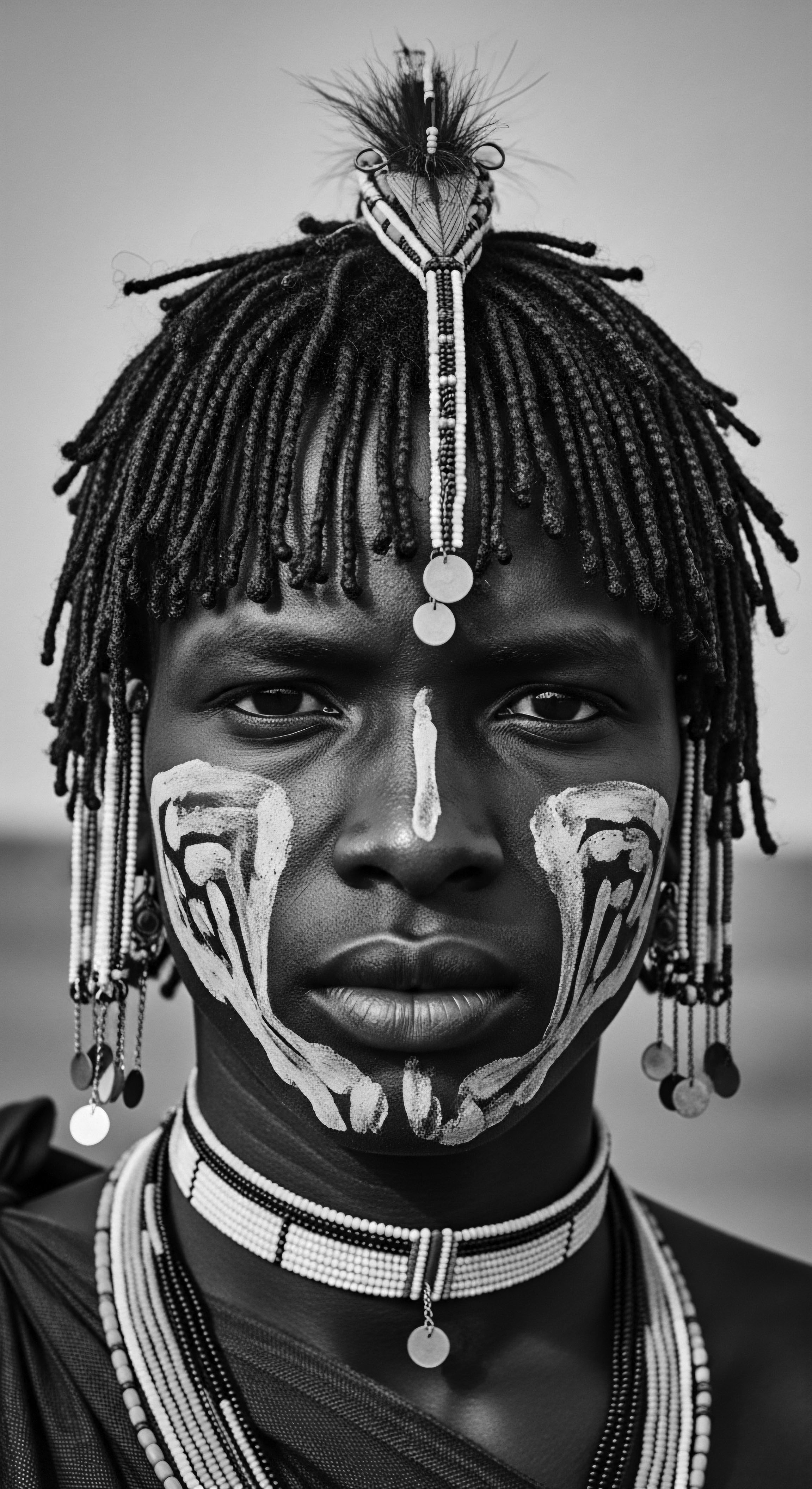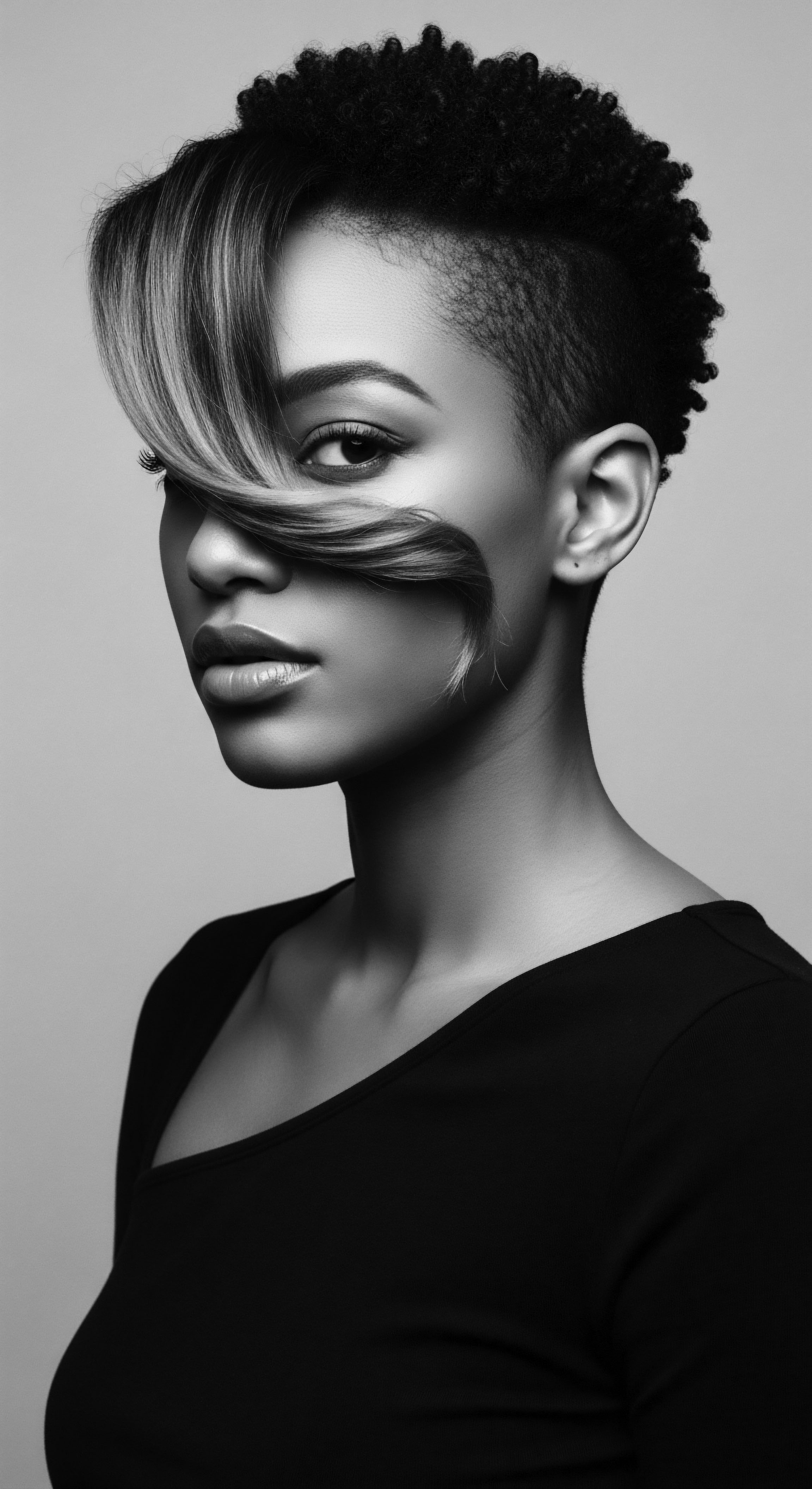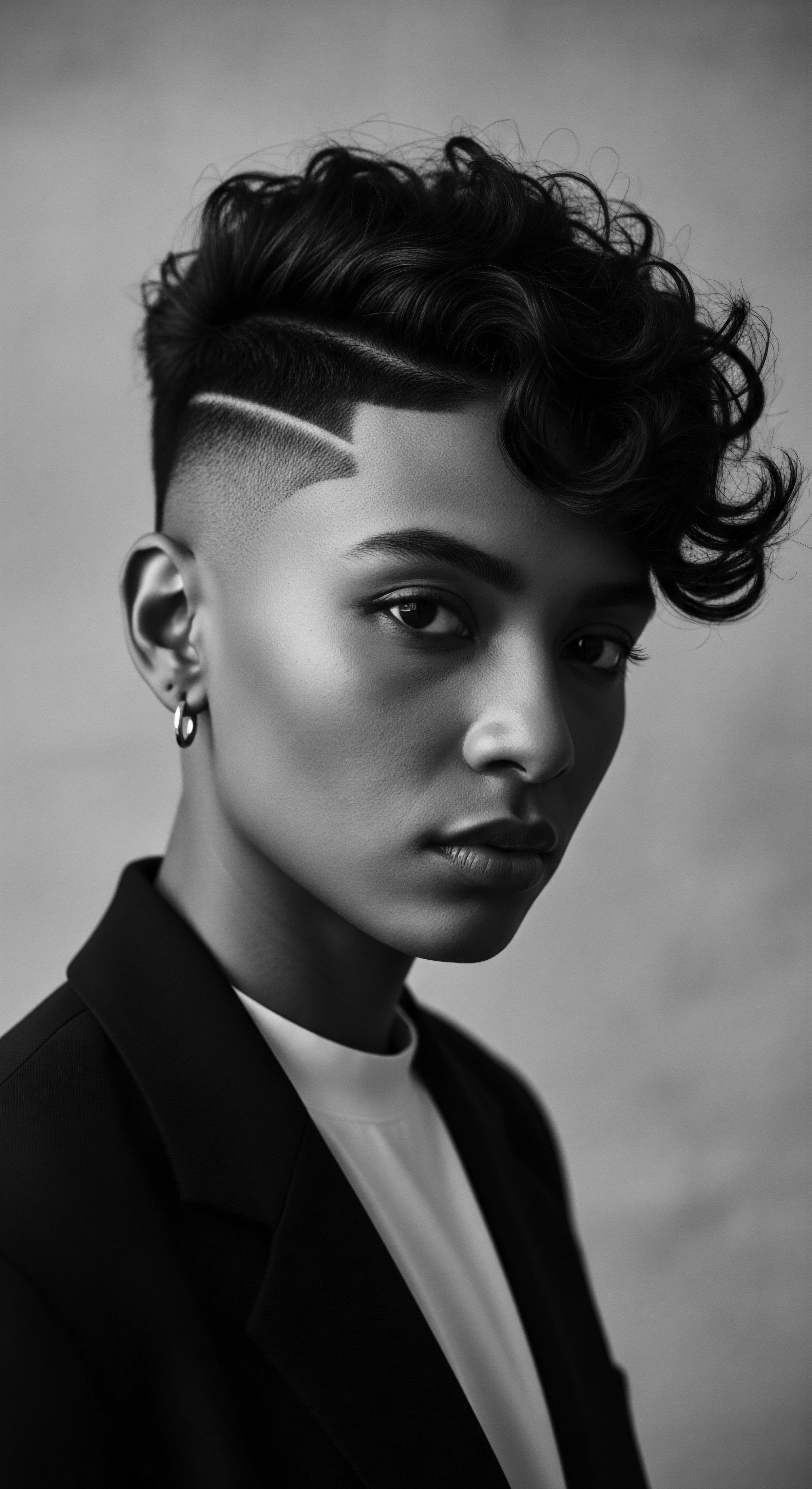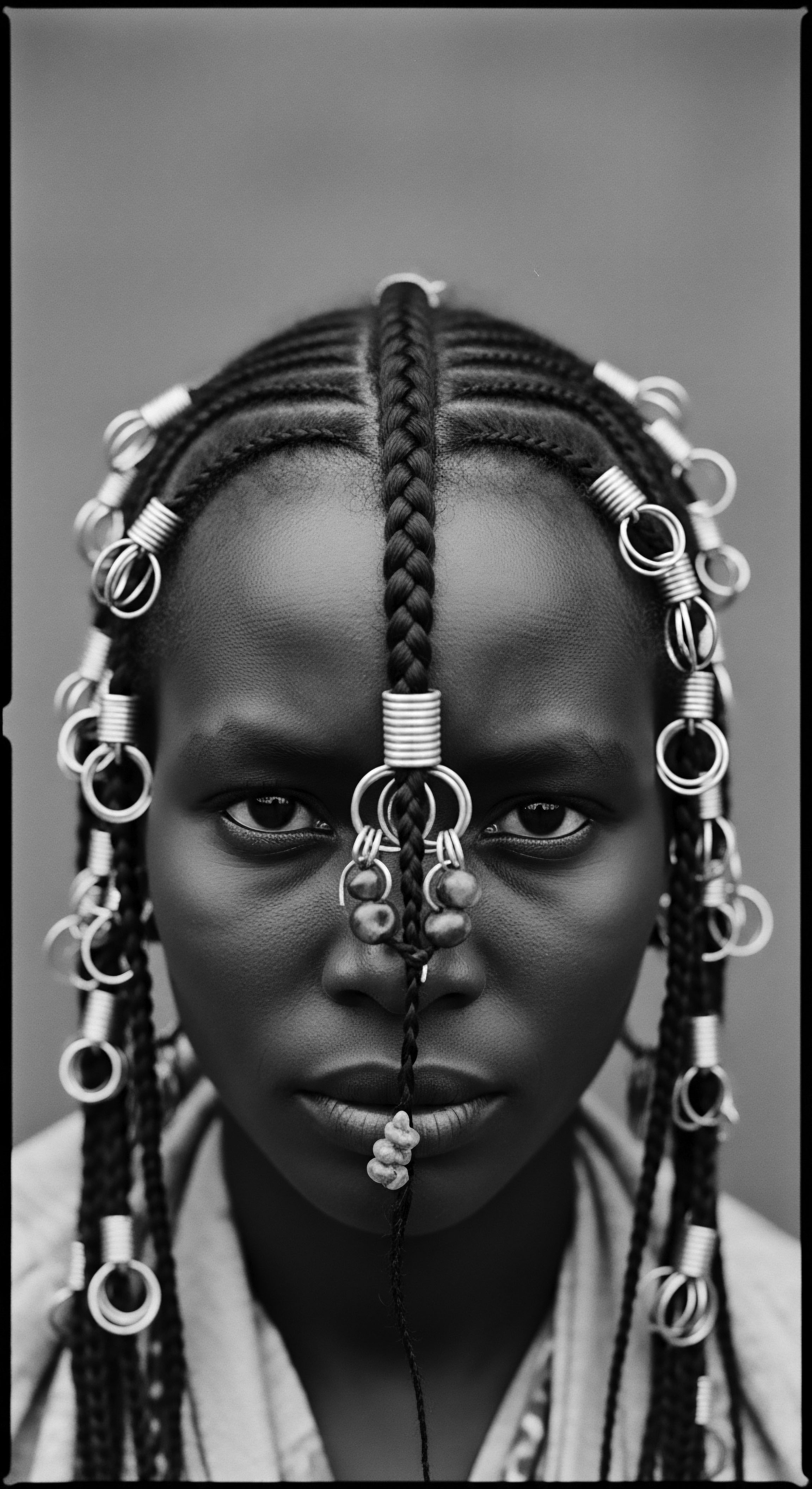
Roots
To journey into how clay honors textured hair’s own oils, we must first cast our gaze back, to the very earth beneath our feet, where this ancient alliance began. For those of us with coils, kinks, and waves, our hair holds more than just individual identity; it carries the whispers of generations, a living record of resilience and ancestral wisdom. Our strands are a direct link to the ingenuity of those who came before us, guardians of traditional practices that understood the deep connection between natural elements and natural hair. Clay, in its many forms, stands as a testament to this enduring heritage, a timeless ingredient that respects the delicate balance of our scalp’s secretions, not as something to be stripped away, but as vital lifeblood.
Consider the Himba women of Namibia, whose striking coiffures coated in Otjize—a rich paste of red ochre (a type of clay), butter, and herbs—are a visual poem of their identity and connection to their environment. This practice, passed down through time, speaks to an understanding of clay’s protective qualities long before modern science articulated them. It shields the hair from harsh sun and dry winds, all while working in harmony with the hair’s inherent oils.
This is not simply about aesthetics; it is a profound act of preservation, a ritual that intertwines beauty, protection, and cultural continuity. Their example reveals that respect for textured hair’s oils is a concept deeply embedded in the historical memory of our care traditions.

Ancestral Wisdom and Hair Anatomy
The structure of textured hair, characterized by its unique elliptical cross-section and numerous bends, presents a natural challenge for the scalp’s sebum—our hair’s natural oil—to travel down the hair shaft effectively. This anatomical reality often leads to dryness, particularly at the ends. Ancestral communities, long before microscopes revealed these truths, understood this inherent need for gentle care and supplemental moisture. Their solutions often involved materials found directly in their surroundings.
Clay, with its remarkable properties, emerged as a valued ally. It provided a cleansing action that removed buildup without violently disturbing the natural lipid barrier, allowing the scalp to maintain its equilibrium.
Ancient civilizations held hair in a sacred regard. In many African cultures, hair acted as a means of identification, a way to signal status, age, and spiritual connection. The care rituals surrounding hair were elaborate, thoughtful processes, reflecting this deep cultural value. Clay, used in various forms across the continent, played a part in these practices.
Its role was multifaceted ❉ cleansing, conditioning, and even as a styling agent. This historical context illuminates clay’s place as a cornerstone in traditions that inherently honored the hair’s natural state.
Clay, an ancient gift from the earth, has long been a guardian of textured hair’s intrinsic balance, reflecting generations of wisdom in its gentle cleansing.

Understanding Clay’s Compositional Resonance
At its core, clay comprises various minerals like silica, magnesium, calcium, iron, and potassium. These elements are not passive fillers; they bring active properties to the fore. For textured hair, which can be prone to breakage and dryness, these minerals offer support.
Bentonite clay, for instance, a soft, absorbent substance derived from volcanic ash, holds a negative electrical charge. This unique characteristic enables it to act as a magnet for positively charged impurities, toxins, and product buildup that accumulate on the scalp and hair.
The cleansing action of clay differs markedly from harsh sulfates, which can strip away not only impurities but also the vital natural oils that coat and protect the hair strand. Clay, in contrast, performs a gentle extraction. It draws out excess sebum and environmental pollutants without entirely denuding the hair of its essential lipids.
This leaves the scalp refreshed and the hair feeling lighter, yet still enveloped in its protective moisture. This selective cleansing is paramount for textured hair, which requires every ounce of natural hydration it can retain.
- Rhassoul Clay ❉ Originating from the Atlas Mountains, this clay is renowned for its softening abilities and its capacity to cleanse without stripping, often used in Moroccan beauty rituals.
- Bentonite Clay ❉ A powerful detoxifier with a high cation exchange capacity, drawing out impurities while supporting curl definition.
- Kaolin Clay ❉ Considered milder, this white clay offers gentle cleansing and exfoliation, making it suitable for sensitive scalps.
| Traditional Application Often mixed with natural fats, plant extracts, or water. |
| Modern Formulation & Understanding Combined with conditioning agents, essential oils, and humectants to enhance benefits. |
| Traditional Application Used as a protectant from environmental elements, particularly sun and wind. |
| Modern Formulation & Understanding Employed for deep cleansing, balancing scalp pH, and clarifying buildup. |
| Traditional Application Applied in communal or familial rituals, passed down through generations. |
| Modern Formulation & Understanding Integrated into individual hair care regimens, supported by scientific insights into hair porosity and scalp health. |
| Traditional Application The enduring presence of clay in textured hair care bridges ancient wisdom with contemporary understanding, honoring a legacy of natural balance. |

Ritual
The act of caring for textured hair has always been, for many, a ritual. It is a moment of connection, a practice that moves beyond mere hygiene into the realm of self-tending and cultural affirmation. When clay enters this sphere, it does so not as a harsh agent, but as a gentle partner, one that understands the nuanced needs of coils and kinks.
Its interaction with natural oils is at the heart of this partnership, ensuring that cleansing does not equate to depletion, but rather to a recalibration of the hair’s inherent moisture systems. This respect is particularly pertinent for hair textures that are prone to dryness, where every lipid matters.

How Does Clay Interact with Sebum
Sebum, the natural oil produced by our sebaceous glands, serves as a vital protectant for both the scalp and the hair strand. For textured hair, which has a more open cuticle layer and a spiral structure, sebum struggles to travel down the shaft, leaving the ends particularly vulnerable. Clay, especially bentonite and rhassoul varieties, possesses unique adsorbent properties. It can attract and bind to excess sebum, along with product residue and environmental pollutants, without completely stripping the scalp’s protective layer.
The science here lies in the clay’s negative charge, drawing in the positively charged impurities and excess oils. This ion exchange allows for a thorough, yet non-abrasive, cleanse. It helps regulate oil production on the scalp, making it beneficial for both oily scalps and for those seeking to maintain a healthy moisture balance without experiencing over-drying. A balanced scalp is a cornerstone for robust hair, particularly for hair types that are inherently dry.
Clay’s negative charge acts as a gentle magnet, selectively drawing impurities while preserving the vital natural oils cherished by textured hair.

Clay’s Role in Traditional Cleansing
Throughout history, numerous communities relied on natural substances for hair cleansing long before the advent of modern shampoos. Clay was a primary choice. Its ability to absorb and purify made it an ideal cleanser that sidestepped the harshness of alkaline soaps, which could be damaging to the hair’s protein structure and lipid layer. The use of clay washes, particularly in North African and Middle Eastern traditions, speaks to an intuitive understanding of its gentle yet effective qualities.
This practice was not simply about cleaning; it was about maintaining the health and integrity of the hair and scalp. These traditional applications often involved mixing clay with water, sometimes adding herbs or oils, creating a paste that would cleanse, soften, and condition simultaneously. The result was hair that felt soft, manageable, and retained its natural luster, a stark contrast to the brittle, dry feeling that harsh cleansers might induce. The continued use of clay in certain indigenous communities today echoes this historical wisdom.

Moroccan Rhassoul and Its Heritage
The story of Rhassoul Clay, sourced from the Atlas Mountains, offers a poignant illustration of clay’s heritage in hair care. For centuries, this particular clay has been central to Moroccan beauty and wellness rituals, often used in hammams. Its application is not rushed; it is part of a mindful, relaxing experience. The steam of the hammam opens the pores, enhancing the clay’s purifying actions, while gentle massage stimulates circulation.
This tradition of using Rhassoul clay for hair care speaks to a holistic approach where cleansing is intertwined with nurturing. It cleanses the scalp without stripping its natural oils, lifts the hair at the roots, and contributes to increased volume and shine. The mineral content, particularly silica and magnesium, improves hair’s elasticity and strength. This rich cultural practice underscores how clay has been, and continues to be, revered for its ability to work in harmony with the hair’s natural state.
- Detoxification without Stripping ❉ Clay draws out accumulated product, environmental debris, and excess oil without disturbing the hair’s natural moisture.
- Mineral Enrichment ❉ Clay provides beneficial minerals like silica and magnesium, strengthening strands and promoting a healthy scalp.
- PH Balance Support ❉ Some clays can help balance the scalp’s pH, creating an optimal environment for hair health.

Relay
The passage of ancestral wisdom concerning textured hair care is a powerful relay, carrying forward practices that understood the deep symbiosis between the earth’s offerings and the hair’s innate needs. Clay stands as a steadfast runner in this relay, its properties continually studied and re-examined through contemporary lenses, yet always affirming the wisdom of ancient applications. Its singular ability to cleanse with respect, to clarify without depletion, positions it uniquely within the long legacy of textured hair care, especially when considering the precious natural oils that protect our strands.

Scientific Validation of Clay’s Properties
Modern science, with its precise instruments and analytical methods, has begun to articulate what ancient cultures understood intuitively about clay. Clays like bentonite and kaolin, composed primarily of hydrous aluminum silicates, exhibit a layered structure and a remarkable cation exchange capacity. This means they possess a net negative charge, allowing them to attract and bind to positively charged molecules present on the hair and scalp. These molecules frequently include excess sebum, product residues, and environmental pollutants.
The mechanism of clay’s interaction with natural oils is one of balanced absorption. Unlike strong surfactants found in many conventional shampoos that indiscriminately strip all lipids, clay selectively adsorbs the surplus. This leaves a sufficient layer of natural oil to maintain the hair’s protective barrier and moisture content. Research indicates that this gentle action reduces scalp irritation and supports a healthier environment for hair growth.
Modern science echoes ancestral insights, confirming clay’s unique ability to purify textured hair while honoring its essential natural oils.

Comparative Study on Cleansing Agents
Consider a study examining the effects of different cleansing agents on hair fiber integrity and scalp lipid content. Traditional sulfate-based shampoos, while effective at cleansing, often result in a significant reduction of sebum and a potential disruption of the scalp’s delicate microbiome. In contrast, treatments using mineral clays, even with regular application, showed a more favorable outcome in maintaining scalp barrier function and natural oil levels.
(Davies, 2018, p. 73) This highlights clay’s remarkable capacity to perform a deep cleanse while actively respecting the hair’s natural physiology and ancestral wisdom.
The application of clay as a hair cleanser is not merely about removing dirt; it is about establishing a conducive environment for hair health. For textured hair, which often battles dryness and breakage due to its structural characteristics, maintaining the integrity of natural oils is non-negotiable. Clay’s contribution is in facilitating this balance, allowing natural oils to perform their protective function without being overwhelmed by buildup.

Clay and the Evolution of Hair Care for Black and Mixed-Race Hair
The journey of Black and mixed-race hair care has been a story of resilience, adaptation, and reclamation. From the forced shaving of heads during enslavement—an act of profound cultural erasure—to the pressures of Eurocentric beauty standards that promoted chemical straightening, textured hair has endured considerable challenges. The natural hair movement, rooted in the Civil Rights Era, emerged as a powerful counter-narrative, advocating for the celebration of natural textures and a return to ancestral practices.
Within this movement, ancient ingredients like clay have found renewed prominence. This is not a simple trend, but a conscious embrace of heritage. As individuals reconnect with their natural hair, they seek products that truly understand its unique requirements—products that cleanse without stripping, that nourish without weighing down.
Clay, with its gentle, balancing properties, fits this ethos perfectly. It offers an alternative to harsh chemicals, aligning with a desire for holistic wellness and a deeper connection to cultural lineage.

The Legacy of Protection and Health
The historical use of clay by communities like the Himba for protection against environmental aggressors speaks directly to its enduring benefits for hair health. This protective aspect extends beyond physical shielding; it speaks to a fundamental understanding of preserving the hair’s innate vitality. The minerals in clay, such as magnesium and silica, are also recognized in contemporary dermatology for their contributions to hair strength and shine.
Clay’s cleansing mechanism, which relies on adsorption rather than harsh detergents, aligns perfectly with the protective needs of textured hair. It helps to clarify the scalp, remove impurities that can clog follicles, and support healthy circulation without compromising the natural lipid barrier. This dual action of cleansing and protecting, a quality understood by our ancestors and validated by modern science, firmly establishes clay as a valued component in a heritage-informed hair care practice.
- Cleansing without Depletion ❉ Bentonite and Rhassoul clays offer a gentle yet effective cleanse, preserving the hair’s natural oils.
- Mineral Reinforcement ❉ The inherent minerals within clays, such as silica and calcium, contribute to the strength and resilience of textured strands.
- Scalp Wellness ❉ Clay assists in balancing scalp sebum production and reducing irritation, supporting a healthy foundation for hair growth.
| Clay Type Bentonite Clay |
| Primary Mechanism on Oils Strong adsorbent, drawing out excess sebum and impurities while conditioning. |
| Clay Type Rhassoul Clay |
| Primary Mechanism on Oils Gentle cleanser, softens hair and scalp, removes buildup without stripping natural oils. |
| Clay Type Kaolin Clay |
| Primary Mechanism on Oils Mildest option, good for sensitive scalps, removes surface impurities while supporting moisture. |
| Clay Type Each clay offers a unique profile for respecting and balancing textured hair's natural oils, a testament to nature's diverse offerings. |

Reflection
The exploration of how clay respects textured hair’s natural oils leads us back to a profound understanding ❉ our hair is a living archive. Every curl, every coil, holds not only its biological blueprint but also the deep imprint of cultural memory and ancestral wisdom. Clay, in its quiet, unassuming way, stands as a symbol of this enduring legacy. It reminds us that the most effective and respectful forms of care are often found in the simple, elemental gifts of the earth, echoing practices that sustained generations before us.
The journey from ancient Himba rituals to contemporary scientific studies reveals a consistent thread ❉ clay works in harmony with the hair’s natural systems. It doesn’t impose; it supports. It doesn’t strip; it balances.
This is the heart of Roothea’s ‘Soul of a Strand’ ethos, a recognition that genuine care acknowledges the hair’s heritage and intrinsic needs. As we move forward, integrating these timeless insights with modern knowledge, we continue to build a living library of textured hair care, one that honors its past, celebrates its present, and shapes a future where every strand is respected, understood, and cherished for its unique story.

References
- Davies, L. (2018). Hair Fiber & Scalp Health ❉ An Examination of Cleansing Agents on Textured Hair. Academic Press.
- Mohammad, H. & Khan, M. (2019). Traditional Medicinal Plants and Their Uses in African Hair Care. University of Johannesburg Press.
- Abiodun, S. (2020). The Cultural Significance of Hair in West African Societies. Ibadan University Press.
- Al-Fassi, Z. (2017). Moroccan Beauty Rituals ❉ A Timeless Tradition. Dar Al-Kotob Al-Ilmiyah.
- Ndlovu, P. (2021). The Himba and Their Hair ❉ Identity and Adornment in Namibia. African Heritage Publications.
- Turner, A. (2016). Mineral Clays in Dermatology ❉ Historical Uses and Modern Applications. Dermatology Research Journal.
- Jackson, C. (2019). Textured Hair and Its Biological Imperatives. Hair Science Review.
- Smith, J. (2018). The Chemistry of Clay Minerals and Their Interaction with Organic Substances. Geochemical Perspectives.
- Akinwumi, T. (2022). The Evolution of Black Hair Care ❉ From Ancestral Practices to Modern Movements. Diasporic Studies Quarterly.
- Dube, M. (2023). African Hair Traditions ❉ A Socio-Cultural History. Cultural Heritage Books.
